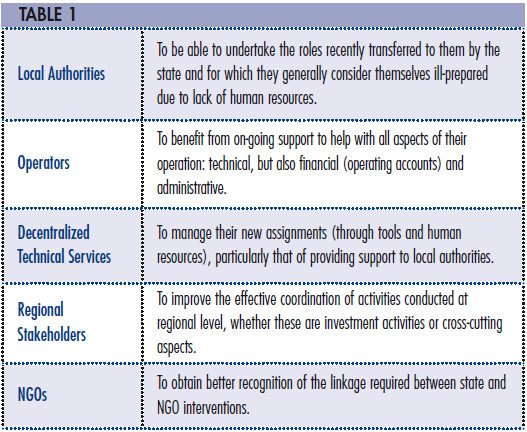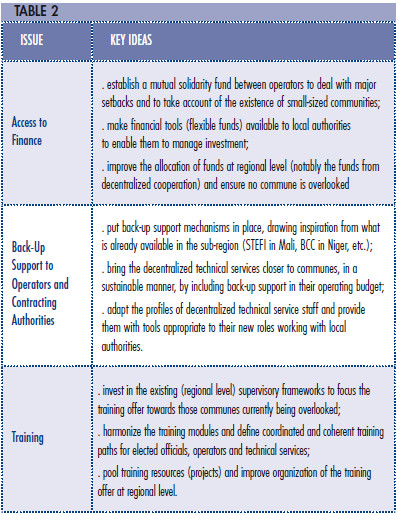The regional level: An appropriate, yet often overlooked strategic level
The CMS program has taken a particular interest in the issue of small towns, which constitute something of
a ‘grey area' and experience several issues with regard to finance, training and back-up support for which there are no sufficiently precise solutions. The region appears to constitute an appropriate level of intervention as, not only does it enable the pooling of tools and services that would otherwise struggle
to remain sustainable were each small town required to manage these separately, but also, at regional level, stakeholders are able to develop a viable level of cooperation and coordination.
In small towns, community-based management of water and sanitation services often finds it difficult to manage complex facilities and offer users more ‘urban' services (24hr service, private connections, etc.).
At the same time, small towns are not large enough either to enable contracting authorities and operators to easily access financial and human resources, or to attract the interest of those operators active in urban areas.
In most African countries, two trends have shaped the institutional landscape of the water and sanitation sector over the course of the last ten years: increased decentralization, including that of water and sanitation services; and the establishment of ambitious national-level investment programs. Today, therefore, the emphasis of public strategies and policies is placed firmly on the national and the local level, with no real consideration being given to developing any link between the two or to the advantage of having an intermediate level.
However, when analyzing the typical geographic positioning of water and sanitation stakeholders within a given country, a ‘regional level' can clearly be seen to emerge out of the stakeholder landscape; a level in which local authorities, decentralized technical services, the private sector and civil society all play a leading role. This is an intermediate level: between the central level where the policies and strategies are developed and the local level where the main aim is to provide services to users.
This regional level, largely overlooked by public policies, offers clear added value with regard to four main aspects: the region constitutes a manageable scale (of around one million inhabitants); it is a suitable size for achieving economies of scale, particularly for the management of small-piped water schemes; it acts as a bridge between the local (notably the community) and the national; it is an appropriate scale for coordinating non-governmental actors.
Access to finance, back-up support, training: high expectations
From the work undertaken as part of the CMS program in three regions of West Africa (Mopti in Mali, Brong Ahafo in Ghana and Centre-Est in Burkina Faso), it was determined that the issues identified at regional level can be grouped together into three main categories.
The first issue identified was access to finance. Local authorities invest very little in water and sanitation as they have low self-financing capacity. As the decentralized services are provided with very few operating resources, this prevents them from carrying out any tasks that fall outside the scope of projects. Banks are not at all involved in financing the sector, despite the fact that a number of operators are in good financial health. Lastly, operating costs vary widely from one small town to the next and, apart from the rare exception, there is no financial solidarity organized on a regional scale.
Back-up support is also generally a significant issue. There is a major requirement to provide support to local operators to accelerate their professional development, ensure a minimum level of regulation and develop benchmarking across all small towns. Local authorities too need similar levels of support with water, sanitation and hygiene services and this need is heightened by the regular rotation of municipal teams. Furthermore, technical services also require
support to develop new tools and align their human resources to the demands of their new role.
The third key issue identified is training. Although there is a training offer available, this is not comprehensive. The offer is not aligned to needs (especially those of the local authorities and operators); there is little regional coordination (too many courses covering too few topics); the offer is poorly distributed over time (as it is too closely linked to projects and programs) and poorly distributed geographically (certain areas are overlooked).
This situation, illustrated in Table 1, creates high expectations among the main categories of regional stakeholder.
Options for action tested with success
CMS guide no.2, How to create a regional dynamic to improve local water supply and sanitation services in small towns in Africa, provides two tools with which to further explore the potential of the regional level:
– a methodology for undertaking a diagnostic of water and sanitation services at regional level that includes all stakeholders and culminates in the development of a regional strategy. This methodology was successfully piloted in the three regions involved in this component of the CMS program;
– examples of specific actions that can be carried out at regional level, some of which have already been piloted in a number of countries (such as the federations of users' associations in Senegal and Burkina Faso, or the technical and financial monitoring systems in Mali and Niger, etc.).
It would take too long to list here all the diagnostic tools and action sheets contained in the guide, thus instead we invite you to refer to the guide itself for more information. We have simply included here (see Table 2) a summary of the basic options from which proposed actions were developed for each of the three categories whose issues and expectations are described above.
Bruno Valfrey
Hydroconseil
Site internet: www.pseau.org/smc/pv

Needs of training, by operators |

Summary of the basic options from which proposed actions were developed for each of the three categories. |
©Lettre du pS-Eau 71 de Dec 2012